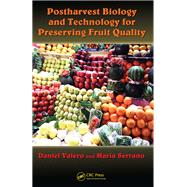- ISBN: 9781439802670 | 143980267X
- Cover: Nonspecific Binding
- Copyright: 5/12/2010
Interest in the postharvest behavior of fruits and vegetables has a history as long as mankind's. Once we moved past mere survival, the goal of postharvest preservation research became learning how to balance consumer satisfaction with quantity and quality while also preserving nutritional quality. A comprehensive overview of new postharvest technologies, Postharvest Biology and Technology for Preserving Fruit Qualityexamines the physical, chemical, and nutritional changes that occur during the ripening process. The book chronicles the changes in postharvest technology during the past three decades, highlighting the advances made possible through a deeper understanding of the postharvest physiology of raw produce. It focuses on how to maintain both sensorial and nutritional fruit quality parameters while also extending shelf life. The authors present a wide range of technological applications for postharvest strategies, including heat treatments, naturally-occurring compounds, modified atmosphere packaging, non-toxic chemical compounds, and active packaging. The text also discusses the advantages and disadvantages of using cold temperatures during handling, packaging, and storage. Although each chapter constitutes a separate unit, which could be used in a stand-alone fashion, the order and continuity of the chapters provide a more complete understanding of the subject. Exploring future directions, the book concludes with coverage of emerging technologies such as atmospheres with high O2, biological control, and the use of UV-light. It offers a firm grounding in the basic knowledge of postharvest research, technology, and applications. The text illustrates a broad range of approaches, based on years of research, and brings them together in a convenient, easily accessible resource.






